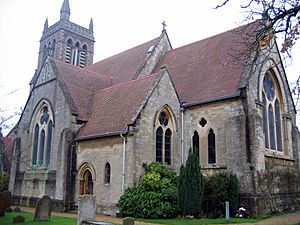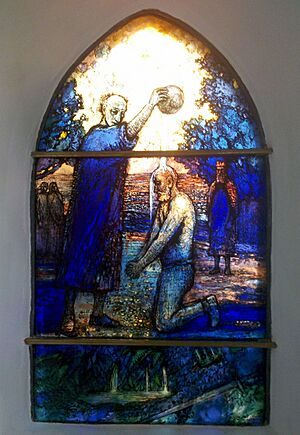St Michael and St Mary Magdalene's Church, Easthampstead facts for kids
Quick facts for kids Church of St Michael and St Mary Magdalene |
|
|---|---|

View of the front of the Church
|
|
| Location | Bracknell |
| Country | England |
| Denomination | Church of England |
| Churchmanship | Liberal Catholic |
| History | |
| Status | Active |
| Architecture | |
| Functional status | Parish Church |
| Heritage designation | Grade II |
| Completed | 1867 |
| Specifications | |
| Bells | 8 |
| Administration | |
| Archdeaconry | Archdeaconry of Berkshire |
| Diocese | Diocese of Oxford |
| Province | Province of Canterbury |
The Church of St Michael and St Mary Magdalene is a special church in Easthampstead, Berkshire. It's a place where people come together for traditional worship. The church welcomes everyone and offers many activities and study groups for all ages.
Contents
History of the Church
The Church in Easthampstead has a very long and interesting history. Here are some important moments from its past.
Early Beginnings
There is no mention of a church in Easthampstead in the Domesday Book. This important record was made in 1086.
The first time the church is mentioned is in 1159 AD. This was when Lawrence, the Abbot of Westminster, gave "the church of Jezhamstede" to Hurley Priory. This gift was to honor Saint Edward the Confessor. In 1176 AD, the church was asked to pay a yearly fee for candles. This payment continued until the Reformation. At this time, the church was called St. Mary and had a stone tower.
Changes Over the Centuries
In 1540, the Abbey of Hurley had to give up its property to the King. Henry VIII then gave the church to Charles Howard in 1544.
Later, in 1696, Sir William Trumbull bought the manor of Easthampstead. He then sold the church's patronage to Thomas Power. Five years later, Power sold it to Christ Church, Oxford. They bought it to help provide places for priests. Christ Church, Oxford, still supports the church today.
The church's first bell tower was made of wood. It was rebuilt with bricks in 1664. A small stone on the tower wall remembers this, with the name Henry Boyer and the year 1664. In 1699, the church had a set of four bells.
The 19th Century Rebuilding
At some point, the church became known as St. Mary Magdalene. The reason for this change is not known. In 1866, the tower was made twice as tall as it was in the 17th century. It was built with brick and decorated with stone. More bells were added, making a total of eight.
Lady Caroline, Marchioness of Downshire, and Revd. Osborne Gordon decided to completely rebuild the church in 1867. They chose J. W. Hugall, an architect from London. He designed the new church in the Victorian Gothic style. Most of the building was made of stone, except for the lower part of the tower.
When the church was rebuilt, it was dedicated to both St. Mary Magdalene and St. Michael. However, a few years later, it became known as St. Michael and St. Mary Magdalene, which it is still called today.
The church is a large building made of stone. It has a chancel (the area around the altar), a vestry, an organ chamber, a nave (the main part of the church), a south transept, a north aisle, a south porch, a baptistery, and a tower.
Inside the Church
Inside the church, you can find several old and interesting pieces of furniture. The original stone font was given a new base. Parts of a screen from the 15th century were used to make a screen below the organ. The pulpit is a mix of Victorian wood and older wood from a Jacobean pulpit.
The Font
The font is the same one from the old church. It has a simple eight-sided bowl on a new base. The screen below the organ seems to be made from parts of an older screen. It has designs from the 15th century below and 14th century designs above.
The Pulpit
The pulpit is made from wood from the 17th century. One part of it has an inscription from 1631. It says: "Unto this place a zeale I beare, to the widdows mit I may cumpear per me William Aylward."
Memorials and Slabs
Many old stone slabs and memorials have been kept from the earlier church. The oldest slab is for Edmund Thorold, who passed away in 1646.
On the north wall, there is a marble slab for Elijah Fenton, a poet from Staffordshire, who died in 1730. On it is a poem written by Alexander Pope. It talks about Fenton being an honest man and a poet who lived a peaceful life.
On the east wall of the nave, there is a small brass plaque. It shows a man in a loose cloak and is for Thomas Berwyk, who died in 1443.
In the tower wall, you can still see the small stone inscribed "Henry Boyer 1664."
There are also other memorials for the Trumbull and Downshire families, for the poet Elijah Fenton, and for the polar explorer Frederick George Jackson.
Stained Glass Windows
The church has beautiful stained glass windows from the 19th century. Some were made by William Morris. There are also four windows by Sir Edward Burne-Jones. The large east window shows the church's patron saint at the Last Judgment. Many people think this is one of the artist's best works in glass.
On June 9, 2013, a new stained glass window was revealed in the porch. It was made by the artist Thomas Denny. The window shows the baptism of Cynegils, King of Wessex. King Oswald of Northumbria and two of Cynegils' daughters are also shown. This baptism helped establish Christianity in the Thames Valley. The window was made to celebrate the 60th anniversary of the coronation of Queen Elizabeth II.
Churchyard and Wildlife
The churchyard is a special place for wildlife. In 2002, it joined the Living Churchyards and Cemeteries Project. It even received an award in 2004. As part of this project, people have been watching the wildlife, putting up bat and bird boxes, and planting wildflowers.
Even though it's in a busy town, the churchyard is a safe place for many animals and plants. More than a hundred types of plants grow here. These include plants often found in churchyards, like germander speedwell, snowdrops, and greater stitchwort.
The old tombstones are home to lichens and mosses. Insects use the small cracks in the stones for shelter. The stag beetle, which is a beetle that is becoming rare, has been seen here. This beetle is important enough to be on the Borough's Biodiversity Action Plan.
The oldest living thing in the churchyard is a very old yew tree near the south gate. It is more than 13 feet around! In February, its male cones release a lot of pollen into the wind.


